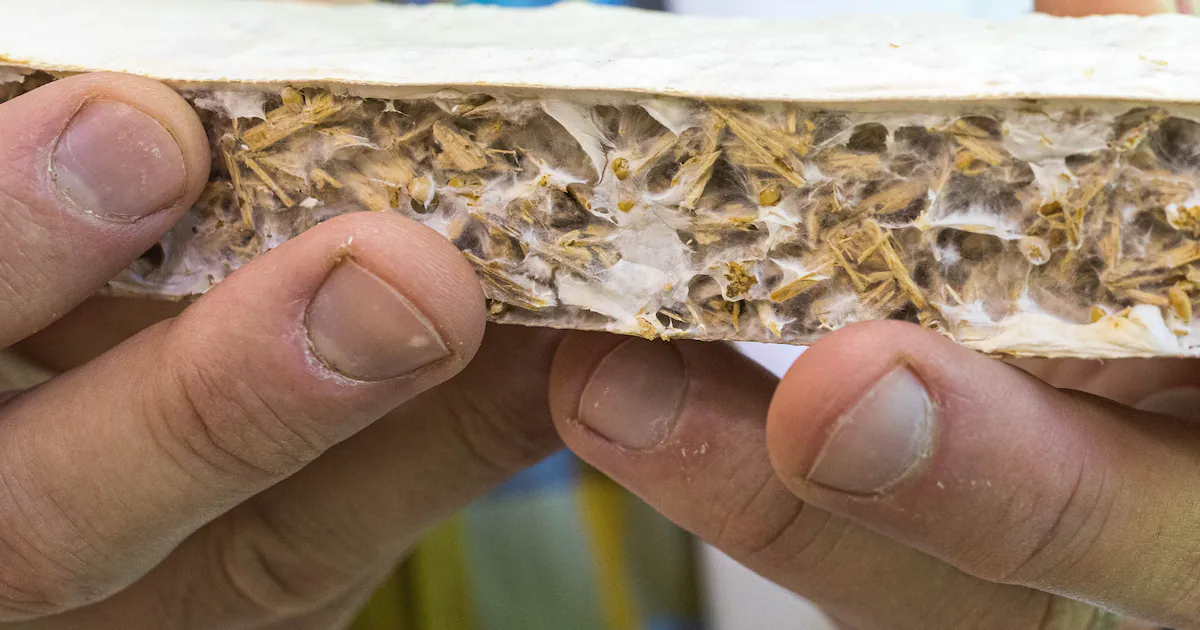Copyright Anchorage Daily News

Just under the forest floor, a vast fungal network known as mycelium builds, communicates and occasionally produces the fruiting bodies we call mushrooms. Now scientists are using this fungus to create insulation to address housing conditions in Alaska’s extreme climate. Climate change has hit rural Alaskan communities hard. Already isolated by a lack of infrastructure and extreme weather, the northernmost state is now facing increasing erosion, flooding, melting permafrost and wildfires. There’s an urgent need for safe, warm and affordable housing. Scientists from the National Renewable Energy Laboratory and the University of Alaska are working on an innovative nature-based solution for housing insulation. [Earlier coverage:Using fungi, UAA team develops biodegradable insulation for shipping Alaska seafood] Alaska faces some of the largest swings in seasonal temperatures on Earth. The Yukon Flats has a record winter low of minus-78 degrees Fahrenheit and a record summer high of 100 degrees. Such extreme temperature variations can make insulating homes difficult and costly. Houses lacking proper insulation and ventilation face increased risks of mold and poor indoor air quality. Residents often add rigid foam insulation boards to the outside of their homes or seal them tightly with poorly made plastic insulation. “Now you are basically wrapping your house in the plastic bag. It doesn’t breathe,” said Philippe Amstislavski, a mycologist and biomaterials researcher in public health at the University of Alaska at Anchorage. Amstislavski co-founded an eco-engineering research project that has developed a new kind of insulation using local wood pulp and a native fungus. When he first moved to rural Alaska, Amstislavski noticed an alarming amount of plastic blowing across the tundra. He began searching for a solution that could harness Alaska’s rich natural resources and replace plastic foam, which is used to package fish and insulate houses but quickly “ends up in our streams, makes its way to the coast, and it ends up in the ocean,” he said. He started a biomaterials lab at the University of Alaska and began experimenting with microbes. But in his search for a water-resistant, lightweight solution, he was able to circle back to an early childhood love, mushroom hunting. Amstislavski grew up in the U.S.S.R., where he spent a childhood foraging in the forest with his parents, who were both biologists. “I don’t think they would convince me to eat any mushrooms, but I do remember very well how we would forage and collect all these different berries and mushrooms,” said Amstislavski. Amstislavski began experimenting with different types of organic matter, from microbes to mushrooms, to see how he could create a Styrofoam-like substance from forest materials. He said he found inspiration by observing the fungal organisms decomposing trees and recycling carbon. To engineer the fungal insulation, Amstislavski teamed up with Robbin Garber-Slaght, a research engineer at the National Renewable Energy Laboratory, to test the experimental materials. Garber-Slaght works in Fairbanks, which has a much more extreme seasonal change in temperatures than Anchorage, where Amstislavski is based. An average resident in Fairbanks may be trying to keep their home at a comfortable 65 degrees Fahrenheit inside when outdoor winter temperatures are minus-15. Amstislavski wanted to test their materials under the intense conditions of that 80-degree differential. Together, they began work on cultivating and creating the bio-insulation, building a mobile test lab in Fairbanks that looks like a tiny house or a little trailer on wheels. Inside are nine different paneled walls, covered in sensors, that the researchers use to test the insulation materials under certain temperatures and humidity. “ It is warm and humid in there. It’s one of the best places to be in the winter in Fairbanks,” said Garber-Slaght. Fungi are natural decomposers. To grow, mycelium needs to feed on wood pulp. Amstislavski wanted to address the abundance of dead spruce trees in Alaska resulting from a beetle infestation that has been accelerated by climate change. “Mushroom feedstock,” Amstislavski called it. Using “all this biomass that’s standing around” has the added benefit of reducing the risk of wildfires, he said. After deciding on the source of wood pulp, Garber-Slaght and Amstislavski had to find a fungus that would feed on it. But mushrooms can be surprisingly selective in their diet, so the search for the right fungus was on. Eventually, they found a “kind of super fungus” that’s “not very picky” about what it eats. “When we fed different types of wood, it would still survive and thrive,” he said. Now that they had their secret ingredient, they needed to perfect the recipe. The first iterations of experimental insulation materials were not structurally sound, said Garber-Slaght. “It looked like a bunch of sawdust with fungus on it.” “ Our goal is to be a one-to-one replacement with expanded polystyrene, which is that white beadboard in Alaska people put on the outside of their buildings to make them more energy-efficient,” she said. The researchers continue to tweak the recipe, but the lab now produces consistent, cost-effective insulation boards that are 100% compostable. To get this result, they take a foamy milkshake of wood pulp and water, add the fungus culture, and pour it into molds. The mixture then incubates in what look like baking racks, allowing the mycelium to grow. After the boards solidify, the lab team uses heat to cure and harden the pulp. The final product results in hard, solid boards of lab-grown fungus insulation that resist water while remaining breathable. They are very nearly thermally equivalent to conventional petroleum-based products. “It seems like a very interesting technique, potentially meaningful to the local community and pretty low-cost,” said Lining Yao, a biomaterials researcher from the University of California at Berkeley, who was not involved in the project. She expressed some concern about the robustness of the technology, since something that is built to be biodegradable won’t be as long-lasting and completely waterproof as the current plastic-based industry standard. Garber-Slaght and Amstislavski are studying the boards’ lifespan and recently completed a nine-year installation review. They found it was still performing as expected. It was free from mold, despite the extreme environment of Fairbanks. “I think there is a need for more studies that look at longevity. It’s very resistant to decay. I think it has pretty good chances of performing for the duration of the life of the structure,” said Amstislavski. In theory, the mycelium can work as both a carbon capture system and a sustainable insulation material, Amstislavski said. But to make the life cycle fully carbon-neutral would require finding sustainable sources of wood pulp and using renewable energy to manufacture the boards. The scientists are continuing to work on honing their product in the hope that it will be picked up commercially. So far, the most interest has been found in a different kind of insulation, as a replacement for popular plastic-foam fish coolers. The scientists say they have big plans for the future of their compostable housing product. “I would love to just grow a building,” said Garber-Slaght. But “we’re not there yet.”



